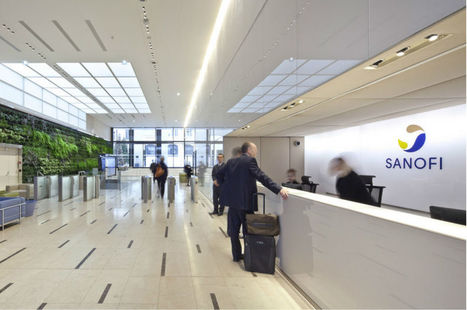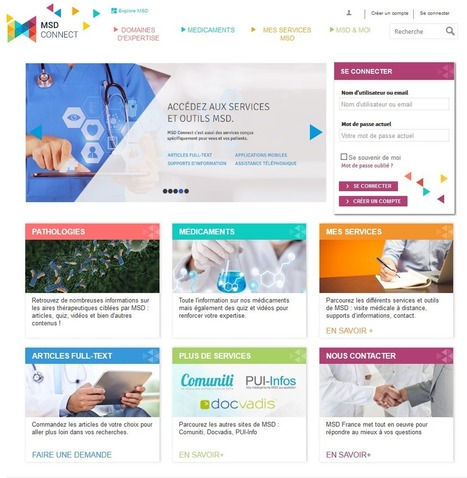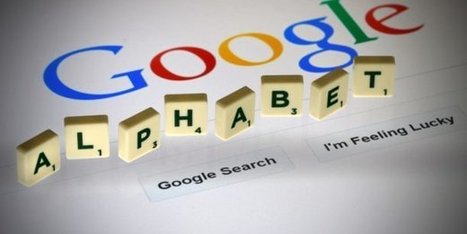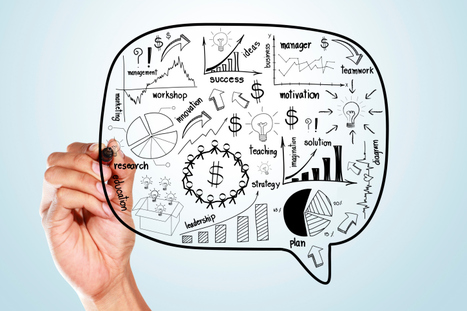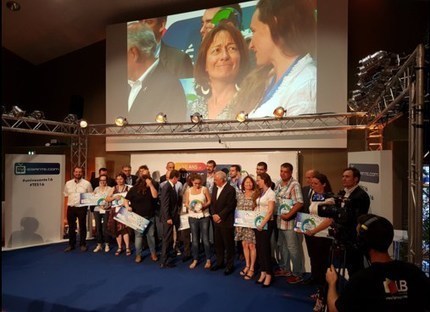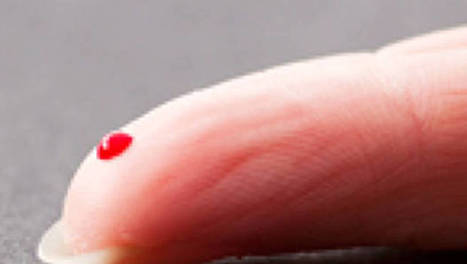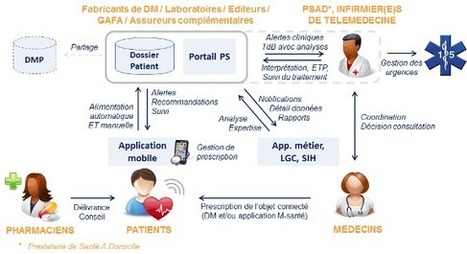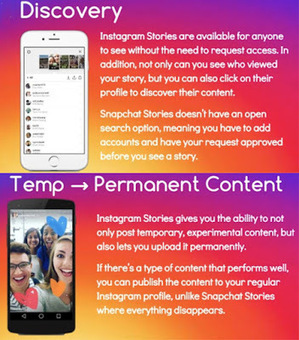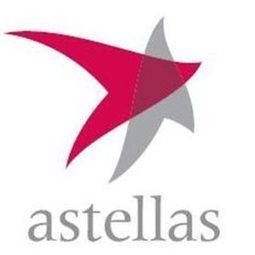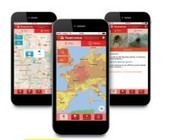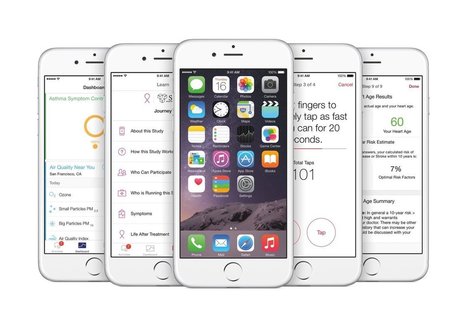 Your new post is loading...
 Your new post is loading...

|
Scooped by
Rémy TESTON
September 14, 2016 12:54 PM
|
The app, called Moodivator and designed with help from the Virginia Commonwealth University of Medicine, includes features such as a mood tracker.

|
Scooped by
Rémy TESTON
September 12, 2016 1:09 PM
|
Verily, l'entité "Sciences de la vie" d'Alphabet (maison-mère de Google), et Sanofi, annoncent la création d'une co-entreprise dédiée à la création d'une plate-forme complète de prise en charge du diabète : Onduo.

|
Scooped by
Rémy TESTON
September 12, 2016 1:16 AM
|
Le géant pharmaceutique français Sanofi et Verily, filiale santé d'Alphabet (Google), ont annoncé lundi la création de leur coentreprise Onduo, qui aura pour mission de concevoir et développer de nouveaux objets connectés dans le domain

|
Scooped by
Rémy TESTON
September 1, 2016 3:13 AM
|
Le laboratoire MSD lance en France une nouvelle plateforme d'information et de services pour les professionnels de santé : MSD Connect. Découverte.

|
Scooped by
Rémy TESTON
August 27, 2016 4:59 AM
|
Multichannel, long a hot topic for pharma, continues to stimulate more debate than an EU referendum. But as models of communication evolve in time with digital revolution, multichannel is not an in/out choice - it's the real world. Pharma is slowly making progress, but excellence? It's not a familiar experience.
Via Philippe Marchal, Lionel Reichardt / le Pharmageek

|
Rescooped by
Rémy TESTON
from Social Media and Healthcare
August 8, 2016 4:34 AM
|
When it comes to incorporating digital and social media in their marketing strategies, drugmakers' efforts are still overshadowed by fear. That's according to Mary Ann Belliveau, Twitter's national health and wellness director. There's a misperception that drugmakers can't use the platform because of regulatory limitations but in fact many firms are doing it and doing it well, she noted. The tech giant's health team works with clients that include Pfizer, Merck, Johnson & Johnson, Novartis, GlaxoSmithKline, Aetna, Cigna, and St. Jude Children's Research Hospital. While the team's primary health focus is on pharmaceutical companies, hospitals, and health insurance companies, wellness companies like fitness centers are also going to Twitter for strategy advice, added Katie Collins, lead healthcare strategist at Twitter. See also: Pharma companies turn to LinkedIn to engage “The most growth we've seen has been from pharmaceutical companies — both on the pharma side and the consumer product side — and also from hospitals,” said Belliveau. Overall, the company reported its slowest revenue growth since it went public in 2013. But one reason Twitter may be seeing growth among healthcare companies is that it can help them reach active patient communities, said Belliveau. Because Twitter is an open platform, patients are quickly able to connect with each other using hashtags, share stories, and seek out information about their conditions. Twitter's demographic profile is broader than some might think, with 23% of U.S. users aged 45 years old and older, and an almost equal ratio of men (49%) and women (51%) represented. Likewise, patient groups on the platform range from those with rare disease to more common diseases like diabetes, noted Collins. “Pharmaceutical companies and hospitals have realized that these conversations and this social care is the area they would like to communicate with, and advertise to,” said Belliveau. “Where the conversations are happening has started to shift from traditional places to social media like Twitter,” added Collins. “So they're trying to figure out how to be a part of that.” Here are eight tips for drugmakers and other healthcare companies to better utilize Twitter: 1. PLAN AHEAD Plan around healthcare events and awareness days. Photo credit: Jenn Vargas/Creative Commons Develop a content calendar focused on healthcare conferences and events as well as disease awareness days so there's time to develop quality content in advance, while also allowing flexibility for relevant in-the-moment content. Having a content calendar is particularly helpful for companies that require a long approval process. “The best companies have good processes in place,” said Collins. “For social, because it's real-time, they have processes in place to get things approved more quickly.” 2. DON'T SOUND LIKE A ROBOT Successful brands deliver an authentic voice. Photo credit: Amber Case/Creative Commons In other words, don't sound cold and sterile. Create a voice that humanizes your brand. Belliveau points to branded and unbranded handles such as @GilenyagoUSOnly, @Eloctate,@CosentyxUSOnly, @ActuallySheCan, and @WhySoAwake that are doing it well. There's “an example of Gilenya replying directly to someone: ‘So glad you made it out. Thanks for coming,'” said Collins. “It's very casual conversational language. It's not clinical or scientific.” Handle Branded vs. Unbranded Company @GilenyagoUSOnly Branded Novartis @Eloctate Branded Biogen @CosentyxUSOnly Branded Novartis @ActuallySheCan Unbranded Allergan @WhySoAwake Unbranded Merck
“I think what makes [these handles] successful is that they're authentic,” said Belliveau. “When they're branded, they talk a lot about their brand and about health but not about the disease state. When they have video that has important safety information, then they do talk about the disease state and have patient testimonials.” The executives recommend developing some pre-approved responses that are genuine, authentic, and ready to use when followers expect a reply. 3. LEVERAGE VIDEO Mayo Clinic is using Periscope to live-stream procedures. Video is the fastest growing creative component being used on Twitter, and such content tends to be driven by patient testimonials rather than by using a TV commercial format, said the executives. “It's just more engaging, with sight, sound, and motion,” said Collins. “The brands that have done it well have excelled at creating relatable content and using good patient testimonials.” When it comes to health, people are also apt to watch videos that last up to seven minutes, said Belliveau. She added that it's likely because they want to learn as much as they can about their condition or disease. Using video is a digestible way for people to consume information and for pharma to get around important safety information often seen at the end of a TV commercial, without a 140-character limit. Additionally, some healthcare organizations are using Twitter's live video-streaming app Periscope. Periscope is being used at conferences, hospital systems such as the Mayo Clinic are using it to live-stream procedures, and insurance companies like Humana are using it to promote events they sponsor. 4. USE HASHTAGS TO DRIVE CONVERSATION With FLONASE Allergy Relief, you can #BEGREATER than allergies and make the most of #NationalHammockDay. 10:03 PM - 22 Jul 2016 4040 Retweets 182182 likes Hashtags have the ability to collect online conversations and house those conversations in a searchable way. Understanding the intentional use of a hashtag is key, and the executives say to use existing hashtags to be part of a larger conversation or create a new hashtag to initiate a brand's own conversation. “Some companies want to be involved in hashtags that are already trending, like #DiabetesDay,” said Collins. “But then other companies want to start their own hashtag to be known for their own consistent message that they incorporate throughout all of their marketing.” If you decide to create your own hashtag, incorporate it in your TV and print advertising as well, said Belliveau. For example, Flonase's #BeGreater is used in different parts of the media strategy. GlaxoSmithKline makes the allergy medication. “They did a trend on Twitter in spring that was “#BeGreater than your allergies,” where they asked users to submit photos of themselves being greater than than allergies, so they had all these submissions of people in a garden,” said Belliveau. “And then they followed it up in the fall with one around pets; hence, people sent in submissions of them with their pets.” 5. SET EXPECTATIONS GILENYA®(fingolimod) ✔@GILENYAGoUSOnly We're all about connecting, but we ask that you follow these rules and understand before engaging with us. 1:10 AM - 14 Jul 2016 Retweets 22 likes Place community guidelines in pinned tweets so users can understand what the expectations are from the get-go. The team at Gilenya, Novartis's multiple-sclerosis drug, for example, pins these kinds of tweets to make clear that patients understand the company operates in a regulated industry and won't be able to respond to every tweet. Drugmakers and other healthcare companies can also set expectations for response times. If the handle is monitored Monday through Friday, companies can use a pinned tweet to address delayed responses for weekend tweets to prevent frustrated customers. “If I were to tweet at you on Saturday night at 11 pm, I have an understanding of what the timing is, the expectations,” said Collins. 6. DON'T IGNORE TWEETS, EVEN WHEN THEY'RE NEGATIVE 28 Jul Valerie @brittybugsmommy Experiences can strengthen you to #StartWithHealthyhttp://bit.ly/2azDAEt ; #HUMemployee pic.twitter.com/npV8Jte12p @brittybugsmommy
That is awesome! Thank you for your support! Keep going strong on your #StartWithHealthy journey! - Marie 7:49 PM - 28 Jul 2016 Retweets likes “When people tweet at you, they don't care if you're American Airlines, Spotify, or Novartis; they expect an answer,” explained Belliveau. “When you don't respond to to your patients, it's like having an empty call center.” Being proactive, even when comments are negative, helps build brand confidence, Belliveau and Collins say. They both recommend responding to negative comments publicly with a short message of acknowledgement and then resolving the issue privately. “You'll see something like, ‘I'm sorry to hear that' or ‘We're disappointed you had a bad experience. Why don't you give us a call and we'll talk about it?'” said Belliveau. That allows other followers of the handle to see the dialogue publicly and feel that the company cares about them. At the end of the day, people want to be heard and the perception of negative comments is usually far worse than the reality, said Collins. “I've never had any companies stop the promotion of their handle because they say, ‘Oh my god. We're getting all this negative feedback and we didn't anticipate it.'” 7. INCLUDE TWITTER IN THE OVERALL MARKETING STRATEGY Digital, TV, and print should all be part of a cohesive marketing strategy. Photo credit: Eigenberg Fotografie/Creative Commons Companies and brands should have a cohesive approach to marketing that includes digital. TV and print is often siloed from digital, but it should be one strategy, said Belliveau. “You're sometimes watching TV or reading a magazine, and you're often on your computer and phone, too,” said Belliveau. “It should all be integrated.” “It's just another extension of the marketing mix that should be a part of everything,” added Collins. 8. SHARE BEST PRACTICES ABOUT HOW FDA-REGULATED COMPANIES CAN USE TWITTER At this year's ePharma conference, Belliveau discussed how the pharma industry can navigate Twitter with attendees . Even though the FDA lacks clear guidelines for how drugmakers can use digital platforms like Twitter or Facebook, there are ways to make it work, insisted the Twitter executives. “Sharing best practices of what other companies are doing, being at conferences to meet people, and share what we're seeing really opens a lot of eyes, because there's so much internal confusion and lack of understanding of what's happening out there,” said Collins. Twitter, Facebook, and Google have been involved in conversations with the FDA to better understand how the companies and brands regulated by the agency can best use social platforms, said Belliveau. “We think that digital in general has really improved the way patients understand the side effects of their medication, because it's in a much more digestible fashion than when you open a box at a pharmacy, and the print is this small,” said Belliveau. “Right or wrong, it's a much more informed and influenced consumer,” said Collins.
Via Plus91

|
Scooped by
Rémy TESTON
August 5, 2016 5:05 AM
|
Depuis 2014, plus des deux tiers des plus gros laboratoires pharmaceutiques du monde se sont associés au géant de la tech. Dernier en date, GSK, le numéro trois mondial, qui a annoncé lundi 1er août la création d'une joint-venture avec celui qui, depuis longtemps déjà, ne se contente plus de cartonner dans les services Internet.
Rares deviennent les big pharmas à ne pas intégrer Alphabet (Google) dans leur stratégie. Dernier en date à avoir franchi le pas, le Britannique GSK, qui a annoncé lundi 1er août la création d'une joint-venture avec Verily Life Sciences (anciennement Google Life science). L'objectif de la société pharmaceutique est de développer et commercialiser des solutions à base d'échanges d'impulsions électriques avec le système nerveux pour traiter certaines maladies chroniques, notamment l'arthrite, le diabète et l'asthme grâce à l'expertise de Verily dans la miniaturisation d'appareils électroniques, le développement d'outils et de logiciels pour des applications cliniques.

|
Scooped by
Rémy TESTON
July 29, 2016 2:53 AM
|
57% des diabétiques T2 associent leur maladie à une restriction alimentaire. C’est pour cela que Sanofi s’est associé à Marmiton pour créer un espace dédié.

|
Rescooped by
Rémy TESTON
from Digital Health
July 25, 2016 2:52 AM
|
Healthcare has been understandably late to the widespread adoption of digital technology. Extremely restrictive regulations, the presence of multiple key stakeholders, a slow-to-adopt culture and other challenges distinguish healthcare from the retail and finance sectors, which have flourished with their implementations of digital technologies. But pharmaceutical companies (pharma) inhabit a unique position, situated between patients, prescribers and payers, allowing them to gain maximum benefits from a wide array of digital offerings.
Via Alex Butler

|
Rescooped by
Rémy TESTON
from Social Media and Healthcare
July 17, 2016 5:14 AM
|
It is well-known that pharma is slow to adopt new advertising technologies. This is tied to the slow moving process for advertising approval based on FDA regulations. However, over the last few years, the following techniques are gaining popularity in healthcare advertising. Mobile – Mobile is the primary new opportunity for advertisers looking to reach HCPs. About 50% of HCP traffic is entering sites on mobile devices and more medical media publishers are offering strictly mobile ad buys.Programmatic – Programmatic refers to using ad buying software to purchase display ads rather than going through the traditional, manual RFP and insertion order process. Programmatic display has been around for over eight years; Google has offered it inside Adwords. Programmatic is more efficient and less costly than traditional advertising. With new programmatic exchanges, dedicated solely to advertising on medical media sites, programmatic is becoming more palatable for pharmaceutical advertisers.Physician Authentication and Targeting – Authenticated physician targeting is becoming mainstream as medical publishers identify larger segments of specialty physicians. The primary way that physicians become authenticated is when a publisher drops a cookie on an authenticated physician’s computer. This cookie is then stored in an ad server and ads may be pushed out to the physician on other websites as the ad server recognizes the cookie. Physician authentication is the golden egg for pharma advertisers – reaching physician specialties with ads for specialty drugs.Social Media Integration – So far, pharma has mostly engaged social media for corporate awareness, educational content, or consumer engagement. Here are a few examples of some realistic social media campaigns that eHS has implemented and have met their metric goals:Twitter chats for both HCPs and consumers to raise awareness of a disease state by engaging them directly in conversation and as a consequence gaining more Twitter followers for the Twitter profiles involved in the chatFacebook paid and organic content to drive both HCPs and consumers to an educational Facebook pageFacebook paid campaign to drive HCPs to an educational website where pharma ads are displayedROI Measurement – ROI measurement of pharma marketing campaigns has been around for a while; however, it can be expensive. Old school programs like Vizu offer brand awareness measurement by surveying people who were exposed to a marketing message. However, now IMS offers a tool to measure physician exposure and Rx lift on campaigns. Yes, I said, “Rx lift!” But the campaign has to be big, really big because the analytics can run $75-$100K and up. So it’s only practical for campaigns of $300K and up, and even then the ROI analytics may be 25% of your costs. If the campaign isn’t big enough, the sample size is too small for statistical accuracy and the expense too large for smaller ad buys. However, look for pricing to come down as IMS competitors get into the ad campaign ROI measurement sphere.
Via Plus91

|
Scooped by
Rémy TESTON
July 11, 2016 6:23 AM
|
Organisés dans le cadre de l'Université d'été de la e-santé, les Trophées de la e-santé ont rendus leurs verdicts. Découverte des lauréats.

|
Rescooped by
Rémy TESTON
from Digital Disruption in Pharma
July 6, 2016 3:02 AM
|
For decades, medical meetings have been a place for doctors, patients, researchers and advocates to engage with each other and share information about the latest advances in treatments and science. That engagement level has exploded over the last few years, however, with the rise of social media. Now, attendees can talk not only to others in the meeting hall but also in every corner of the globe. How important has social media grown to become at medical meetings? Consider: The 2013 American Society of Clinical Oncology (ASCO) Annual Meeting saw 4,352 different people tweet 21,861 times using the #ASCO13 hashtag throughout the year. Two years later, the #ASCO15 meeting was mentioned in 81,273 tweets from 16,664 people – a nearly four-fold increase. AstraZeneca once again will participate in major meetings in our therapeutic areas this year, including ASCO, AHA, ACC, ADA and several others. In addition to our live presence at the meetings, we hope to accomplish the following through our social engagement: Conduct live, authentic dialogue with those in attendance as well as those following along virtually.Share our messages and resources with an informed, engaged audience.Continue conversations begun face to face in the meeting halls.Glean key areas of focus of those affected by the diseases being studied to better inform our efforts as a company. It is increasingly crucial for all players in healthcare to be engaged in social media, as more and more Americans use these platforms.
Via Pharma Guy
|

|
Rescooped by
Rémy TESTON
from Social Media and Healthcare
September 13, 2016 2:27 AM
|
The biggest challenge to treating patients with diabetes isn’t doling out medications, it's making sure that people control their habits. Poor diet and lack of exercise generally create complications with the disease. To combat the problems, researchers in the diabetes division of Sanofi US took an unusual step for Big Pharma: they went social, jumping into online networking with a Facebook page, Twitter presence, and eventually three different engagement platforms. "Treatment is an important aspect to blood sugar management, but it isn’t the only aspect," says Laura Kolodjeski, Sanofi’s diabetes community manager, who has become the virtual face of the company. "There is a huge community of people already that live with diabetes and are connecting and sharing [online] to improve each other’s experience with the disease." Laura Kolodjeski Sanofi now helps direct and police those interactions online. The company won’t release total visitor numbers, but it has about 4,000 followers on Facebook and another 4,000 on Twitter, all of whom are sharing links to broader content. And for better or worse that community is going to grow: About 8 percent of Americans or roughly 26 million people have diabetes, and the Centers for Disease Control predicts that as many as one third of us could have the disease by 2050. But the social frontier is potentially prickly for Sanofi because the FDA has not yet written the rules about how pharmaceuticals are allowed to engage with potential customers and patients. The only guidelines came out in a December 2011 advisory statement declaring that while allowing virtual comments about things like off-label uses isn't technically illegal, it's shady territory; basically, pontificate at your own risk. "We are working on the area and it's something we feel is important but we don't have a specific timeline right now," says Ernest Voyard, senior regulatory council at the FDA's Office of Prescription Drug Promotion. For Sanofi, drawing up their own social media strategy is also a defensive move: In 2010, the company's cancer division suffered a PR nightmare after a patient, who claimed to have experienced permanent hair loss from one of their treatment drugs, posted complaints and photos on that group's unmonitored Facebook page. John Mack, the editor of Pharma Marketing News, which tracks shifts in the pharmaceutical industry, says such hits are common anytime you try to pioneer a new space. "They've had some rough times, but they are learning a lot," he adds. We really allowed the community to help identify what might be useful to them and where they might go next Mack considers Sanofi a leader in the category, especially compared with the offerings from other companies. Diabetes juggernaut Novo Nordisk sponsors IndyCar driver Charlie Kimball to tweet @racewithinsulin, including when he injects with their products. And Pfizer's ThinkScienceNow blog about developments and advances in research is wonky but not exactly customer friendly. Sanofi has created a template they hope will eventually be deemed both acceptable to the FDA and cool for customers. The lessons they've learned in the last two years is a valuable addition to The Social Media Roadmap from our current issue. BE TRANSPARENT When she took over as social media director, one of the first things Kolodjeski did was post a bio with a photo of herself online at DiscussDiabetes to show who was moderating. She also disclosed that she wasn’t diabetic. Why? To build trust, the kind community members might not have for a faceless company run by mostly non-diabetics. The message: "If Laura is going to work every day to solve [issues] on our behalf, then others must be doing the same," Kolodjeski says. Rather than just explain the rules of their forums in a jargon-y "terms of use" agreement Kolodjeski also tapped Mark Gaydos, head of the company’s U.S. regulatory affairs for marketed products division, to do a Q&A about how the sites would function. For instance, anytime someone on the site mentions a product, they are technically promoting it, so there needs to be fair balance of potential benefits and risks explained alongside that per FDA guidelines. That means many posts get quarantined internally before posting, so the company can add additional links or annotations to more information. Sanofi only wants to allow discussion of FDA-approved uses for products—any mention of possible side-benefits or bonuses from tweaking the usual dose regimen is prohibited. To make sure everything meets these requirements, there is often a delay—sometimes up to 24 hours—between when users make comments and those comments become publicly visible. To explain their business interest, Kolodjeski also interviewed Dennis Urbaniak, the head of the company’s U.S. diabetes business unit to explain what he calls the "360-degree partner" principle—an effort to inspire others to talk more and tap into that as a focus group for new ideas. LET USERS SHAPE EXPANSION Sanofi launched their diabetes Facebook and Twitter handles in September 2010 mainly to offer news updates about the company and its offerings. On Facebook, any clinical questions were directed to a separate tab and often answered privately. On Twitter, medical concerns were covered via direct message. What was missing was a way to collect various poster’s lifestyle tips and inspirational messages all in one place. In January 2011, the company launched DiscussDiabetes to address that. They also run their own stories about successes, including highlights from A1C Champions, another company sponsored group of diabetics who have maintain the best or "A1C" target range of blood sugar levels. By March of this year, the company took a look at the discussions that were being generated and realized that terms like A1C weren’t actually as universally understood as they once thought. To speed that learning curve, they launchedDiabetepedia, which provides both simple definitions and links to other sites showing how terms are actually used in other online conversations. The final step: After noticing how activity at Diabetepedia was spiking, Sanofi launched another site collecting lots of the content they were already linking to all in one place. The DX, which launched at the end of May, hosts daily dispatches by both Kolodjeski and stable of already popular bloggers (none of whom are paid directly) that include everything from a diabetes related comic strip to mommy blogs for parents with diabetic kids. "We really allowed the community to help identify what might be useful to them and where they might go next," Kolodjeski says. GIVE USERS EVEN MORE CONTROL The medical glossary at Diabetepedia doesn’t just provide standard definitions to complex terminology, users are encouraged to submit their own entries, creating a sort of slang dictionary that makes complicated stuff more relatable to newcomers. For instance, glucoaster: that’s shorthand for "a rollercoaster of blood glucose levels, with blood sugar lows followed by blood sugar highs." User contributions have helped the database grow by 30 percent to include more than 150 terms, all of which make it easier to users themselves to better convey thoughts in future postings. The company also considers each media outpost an exclusive "channel," which means there is lots of cross-posting of content from different platforms to make sure users who only tune into one place are being best served. "We certainly have people that overlap but for the most part people have selected which channel they feel represented by and communicate through," Kolodjeski says. But at each stop, the company still tries to crowdsource bigger ideas. This year, they asked users to help set priorities for the company’s annual Data Design Diabetes Innovation Challenge, which asks individuals, businesses and non-profits to create new initiatives for using big data to help others struggling with the disease. To help brainstorm for that, Sanofi’s social media troop was given the chance to visit a competition homepage and answer questions about what aspects of life with the disease might be consistently overlooked or ignored. Their answers were used to shape a final guideline for contestants that solutions must address the overall wellness and family life of patients, not just symptom mediation. The winner: a program created by the n4a Diabetes Care Center that matches people with certain cost or risk profiles directly to the services they might need to slow the progression or expense of the disease. Mood problems can be addressed by better disease management, hopefully cutting into the 18 percent of all diabetics who require hospitalization each year. After realizing just how open users are to sharing and connecting, Sanofi also launched their own new product, the iBGStar, a personal blood glucose monitor that plugs directly into an iPhone or iPod Touch with an app that saves data and maps correlations between blood sugar levels and meal times, carb and sugar intake, and physical activity. Users can share results with their family or email them to health care providers. But the product, which hit the market in May 2012, wasn’t just inspired by early community actions; ensuing reviews and comments in their own forums will help refine future updates. "It’s a big hit with the online community," Kolodjeski says. "It’s also given us a great opportunity to prove back to them that if we hear someone comment about something, we have the ability to engage in a public manner." Correction: An earlier version of this article said that iBGStar came on the market in 2011, it was released in May 2012.
Via Plus91

|
Scooped by
Rémy TESTON
September 12, 2016 3:18 AM
|
Les deux groupes donnent un contenu plus concret à l’alliance annoncée l’été dernier. Leur filiale Onduo va mettr

|
Rescooped by
Rémy TESTON
from Pharma Hub
September 10, 2016 3:35 AM
|
Johnson & Johnson has teamed up with a subsidiary of HP to focus on personalisation of instrumentation and software for patient-specific healthcare devices.
Via Philippe Marchal

|
Rescooped by
Rémy TESTON
from E-santé, Objets connectés
September 1, 2016 2:52 AM
|
L'industrie pharmaceutique a abordé cette révolution avec retard, se limitant généralement à « digitaliser » des solutions existantes dans une perspective classique de promotion du produit. A l'heure de la m-santé, les laboratoires sont en train de (...)
Via Bruno Demay
iDespite the fact that FDA recently cited Duchesnay for a violative Instagram Diclegis ad that featured celebrity Kim Kardashian, Instagram may be the social medium of choice of pharma marketers now that it has added a new feature. Until now, I didn't think Instagram was good for pharma. While its demographics may skew too young for marketing most of the products pharma has to sell, it is a growing population. Plus, now that it is owned by Facebook, the demographics -- especially among women (the best target for drug marketing) -- will likely shift to resemble FB's demographics. According to eMarketer, now that Instagram is open to all advertisers, by the end of 2016, 48.8% of marketers are expected to the platform. Of course, due to FDA regulations, the necessity to expend resources to monitor comments for adverse reactions (read "One (BIG) Reason Pharma Shouldn't Reconsider Instagram"), lack of expertise in measuring social media ROI, etc., pharma marketers have not given social media a warm reception no matter what the platform. Continue reading to see why I feel a new Instagram feature will make it more appealing to pharma marketers.
Via Pharma Guy

|
Rescooped by
Rémy TESTON
from Digital Health
August 7, 2016 4:31 AM
|
With investments in the digital health marketplace accelerating at a rapid pace, Astellas Pharma Inc. and DigiTx Partners LLC have announced that Astellas has launched DigiTx Partners, a digital health investment company in partnership with MPM Capital, Inc.
DigiTx Partners will invest in the digital health space broadly, with a special focus on companies which create solutions that improve patient outcomes and provide substantial synergy with a broader pharma business. Although the emphasis will be on earlier stage companies, investments will be made in both start-ups and growth stage companies.
Via Alex Butler

|
Scooped by
Rémy TESTON
August 2, 2016 4:48 AM
|
La maison mère de Google continue de se placer dans la pharma.
Son entité dédiée, Verily Life Science, a signé un troisième partenariat avec un géant du secteur : le britannique GSK.

|
Scooped by
Rémy TESTON
July 28, 2016 1:23 PM
|
Pour IBM, Phillips, Microsoft et les labos, la technologie derrière le bitcoin permet de sécuriser les données sensibles de santé et améliorer la transparence du secteur.

|
Scooped by
Rémy TESTON
July 18, 2016 5:11 PM
|
Merial, la division santé animale du groupe Sanofi, vient de lancer l’application FleaTickRisk qui évalue en temps réel par localisations géographiques les risques d’infestation ou de piqûre par les puces, les tiques, et certains insectes volants tels les moustiques et les moucherons piqueurs (phlébotomes).

|
Rescooped by
Rémy TESTON
from Pharma Hub
July 17, 2016 5:13 AM
|
Apple's ResearchKit was quickly adopted by clinical studies at a series of universities and hospitals, but a new iOS app focused on rheumatoid arthritis from pharmaceutical firm GlaxoSmithKline marks the first time a drug company has made use of the framework.
Via Philippe Marchal

|
Rescooped by
Rémy TESTON
from Social Media and Healthcare
July 11, 2016 2:30 AM
|
I have a confession to make… Despite the fact that I spend all my working life writing, talking and thinking about digital media and marketing, I’ve only just figured out Snapchat.
Since the photo-sharing app launched in July 2011, I’ve probably put it on my phone, and deleted it, half-a-dozen times because I just didn’t get it. But recent changes had me look again and now I think I’m beginning to see what all the fuss is about. Just in case, like me, you struggle with Snapchat, here’s a quick primer on what it is and why you might want to take a closer look… Snapchat is a mobile messaging app, initially used to share photos (snaps) that ‘self-destructed’ seconds after they had been viewed. Now, increasingly focused on video and featuring text overlays, photo and geo filters and more emojis that you can imagine, messages sent directly still disappear on viewing, but users now have the option to curate ‘Stories’ where messages last for 24 hours. The network is the fastest growing in social media’s short history, achieving more than 100 million daily users in just four years. And, despite Facebook and Google reportedly trying to buy it for between $3 and $4 billion, Snapchat it is still independent and now valued at $20 billion. A younger crowd Don’t feel bad if you didn’t know any of that about Snapchat: You’re probably too old to be using it. Demographics for the platform’s user base skew pretty young – 60 percent of US Snapchat users are under 25; 86 percent are under 35. And the fact that ‘old’ people like me never got Snapchat actually factors in its stellar success. In a survey run earlier this year for Variety magazine, 30 percent of respondents said one of the things they liked most about the social media network was that ‘My parents don’t use it’. There are probably several PhD theses being written right now about why more the mature social media user has never taken to Snapchat, but for me it always just seemed too… immature. While I totally get the attraction for teenagers to overlay rainbow vomit on their selfies, it just never seemed like that would add anything to my communications. Add to that the fact that messages lasted no more than 10 seconds and I always questioned the point. What if I forget what was said in a message? What if I read it but I’m too busy to reply right now? That’s way too much pressure for an old guy. So what changed to make this fun but largely pointless playground app a serious marketing option? Storytelling For me, Snapchat really only started to make sense as a media and marketing platform when it pivoted away from being a pure messaging app and morphed into a publishing platform where users, publishers and brands can curate and tell stories. If you swipe left now on Snapchat, away from the once essential camera screen, you move into the app’s ‘Stories’ section where users can view and subscribe to content that has been curated into mini-magazines. Publishers, including old-school titles like Cosmopolitan and National Geographic as well as online media like Vice and Buzzfeed, have been quick to partner to get their content out to the ever-increasing Snapchat audience. The format is still very Snapchat. Inside ‘Discover’ channels, users swipe through images or animations overlayed with text, doodles emojis, but now there is actual content – articles or videos – beneath the opening snaps. Also, the broadcast only nature of Snapchat has changed. Users can now share content with friends, finally bringing the notion of virality and the power of social sharing to Snapchat and no doubt fueling the interest of brands fromGatorade to General Electric in the platform. Intimacy at scale None of this means that Snapchat is in any danger of becoming just a publishing platform any time soon; 71 percent of respondents in the Variety survey said that they preferred the app for its chat, messaging, and imaging services. Combine the persistence of its messaging functionality, with incredible growth, an exclusive mobile focus, the increasing volume of video on the platform and engagement levels ‘to die for’, and Snapchat could become a very interesting place to be for Pharma marketers targeting younger patients. Writing last year in Ad Age about opportunities for brands joining the platform, Victor Pineiro of the Big Spaceship agency highlighted Snapchat’s ability to deliver what he called ‘intimacy at scale, “Every time a user opens a snap, she has no idea who else – if anyone – is seeing it. It's a tiny, personal gift, even when broadcast to a huge audience.” That intimacy is important to many patient communities. Michael Smith, Senior Digital Strategist at Palio+Ignite, has written, ‘there are certain communities within healthcare marketing that do not lend themselves well to public social media campaigns’. For these groups, he sees apps like Snapchat allowing marketers to develop a ‘social, but private relationship with their target audience without having to drive them to a branded platform’. Of course any advice for Pharma to consider using a social media platform has to come with the usual advisories and warnings. The 24-hour shelf life of Snapchat messages might heighten engagement as users log on to avoid FOMO (fear of missing out), but Pharmaguy suggests it might not be a ready answer for FOFDAR (fear of FDA regulations) even if it would be difficult for the FDA to document transgressions before offending materials have disappeared. The transience of Snapchat messaging probably doesn’t make it the best place for straight up drug promotions, but it may be effective in promoting educational events or directing people to more permanent sources of information like websites, or for ongoing patient support and adherence. I find it fairly easy to imagine a teen diabetic subscribed to an information channel on their smartphone that sends daily treatment reminders and regularly share messages of support from within the patient community, healthcare professionals and even celebrity ambassadors… especially if they use that rainbow vomit filter.
Via Plus91
|



 Your new post is loading...
Your new post is loading...



